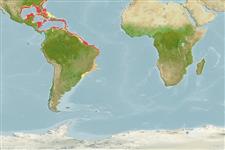Common names from other countries
Teleostei (teleosts) >
Eupercaria/misc (Various families in series Eupercaria) >
Haemulidae (Grunts) > Haemulinae
Etymology: Haemulon: Greek, haimaleos = bloody (Ref. 45335).
More on author: Linnaeus.
Environment: milieu / climate zone / depth range / distribution range
Ecology
Marine; reef-associated; depth range 10 - 210 m (Ref. 27283). Subtropical; 35°N - 33°S, 98°W - 33°W
Western Atlantic: Bermuda, Florida (USA), western Bahamas, and Gulf of Mexico to Brazil. Also Caribbean, including Antilles (Ref. 26938).
Size / Weight / Age
Maturity: Lm ? range ? - ? cm
Max length : 28.0 cm TL male/unsexed; (Ref. 7251); common length : 17.0 cm TL male/unsexed; (Ref. 3798)
Dorsal spines (total): 13; Dorsal soft rays (total): 13 - 14; Anal spines: 3; Anal soft rays: 8. Scale rows below lateral line oblique; head entirely scaled except for front of snout near upper lip and front of chin; snout very short; the maxilla not reaching a vertical through center of eye; silvery gray with five dusky yellow stripes, the two lowermost the broadest (Ref. 13442).
Occurs along exposed outer or deeper reefs. Found on semi-hard substrates (Ref. 5217). Maximum depth down to 210 m was recorded from individuals observed by submersibles (Ref. 27283). Feeds mainly on plankton (Ref. 5217); small crustaceans (Ref. 26938).
Life cycle and mating behavior
Maturities | Reproduction | Spawnings | Egg(s) | Fecundities | Larvae
Oviparous, distinct pairing during breeding (Ref. 205).
Robins, C.R. and G.C. Ray, 1986. A field guide to Atlantic coast fishes of North America. Houghton Mifflin Company, Boston, U.S.A. 354 p. (Ref. 7251)
IUCN Red List Status (Ref. 130435)
CITES (Ref. 128078)
Not Evaluated
Threat to humans
Harmless
Human uses
Fisheries: minor commercial; aquarium: public aquariums
Tools
Special reports
Download XML
Internet sources
Estimates based on models
Preferred temperature (Ref.
115969): 21.4 - 27.8, mean 25.5 (based on 392 cells).
Phylogenetic diversity index (Ref.
82804): PD
50 = 0.5000 [Uniqueness, from 0.5 = low to 2.0 = high].
Bayesian length-weight: a=0.00389 (0.00180 - 0.00842), b=3.12 (2.94 - 3.30), in cm Total Length, based on all LWR estimates for this body shape (Ref.
93245).
Trophic level (Ref.
69278): 3.4 ±0.45 se; based on food items.
Resilience (Ref.
120179): Medium, minimum population doubling time 1.4 - 4.4 years (Preliminary K or Fecundity.).
Fishing Vulnerability (Ref.
59153): Low vulnerability (18 of 100).
